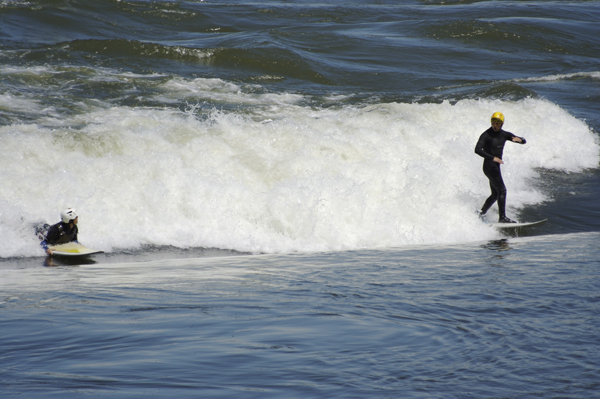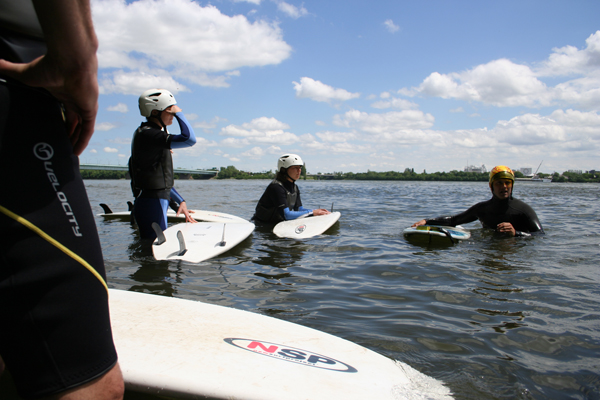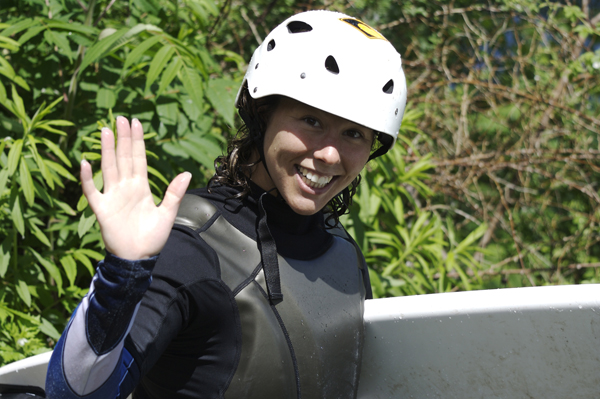MONTREAL - From the famed bagels to the dozens of eclectic festivals, there are numerous reasons to visit Montreal. But here’s one that’s probably not on your radar: River surfing.
Montreal, in fact, is one of the best places to learn this sport.
Surprised? So was I, which is why I had to take the plunge.
I should preface this by saying I’m no expert surfer. I had my first surfing experience at 18 when I was vacationing in Hawaii with my family. My sister and I had been sunning ourselves on Waikiki Beach when we decided a surfing lesson would be cool — and might even make us look cool, too. Instead, I provided great entertainment for other beachgoers, as I face planted in the water every time I tried to stand.
My second experience, though, was even worse: During a recent cruise on Royal Caribbean’s Oasis of the Seas, I took such a bad spill on a Flowrider surfing simulator that my shoulder ached for weeks.
So I’m a little nervous about hopping back on a surfboard, but I’m intrigued about river surfing — and completely confused.
Apparently, I’m not alone.
“People often ask how I can stand on the board while I go down the river,” says Hugo Lavictoire, owner of Kayak Sans Frontieres which offers lessons in numerous water sports, including river surfing. “They think I actually go down the river standing up on my board.”
That’s far from the truth.
Unlike ocean surfing where you have to wait for the waves to come, waves in rivers are created by rocks. Because those rocks don’t move, the waves become a permanent fixture, which means you can stay on that wave and ride to your heart’s content, or better yet, until your legs cry uncle. Once you’re done, you exit the wave, climb out of the water and go again — if you prefer.


Left: Once you master the technique, river surfing is lots of fun. Right: Instructors get in the water to teach students.
But is one easier than the other?
I’m hoping Lavictoire’s going to tell me river surfing has the edge, given that I’ve failed miserably at ocean surfing. But he shakes his head and says no, they’re simply different. “Yet learning how to river surf will make you a better ocean surfer and vice versa,” he says.
So on a sunny summer day, a few other river surfing newbies and I, who have booked this lesson through the Fairmont Queen Elizabeth’s Surf’s Up Montreal package, head to a part of the St. Lawrence River where two permanent waves make their home.
This is one of the city’s hottest surfing spots — surfing exploded onto the scene in Montreal in 2006 — and during prime surfing hours, people come out in droves to surf these two waves. When the crowds swell, etiquette is key: If there’s a line, your hang time on the wave gets cut to two minutes. That may not sound like much, but as Lavictoire notes, “two minutes is a long ride if you compare it to the ocean where you’re happy with a 15-second ride."
Before we can hop in the water, though, we run through safety basics on land, including what certain hand signals mean (tapping our head with our fist means we’re okay, for instance) and how to attach the board’s leash to our ankles. We’re also dressed up in wet suits, booties and helmets — there are rocks in the river, after all — and then we make our way to the river’s edge.
Truth be told, the most difficult part of river surfing at this location is getting to the river. A narrow dirt path leads to the St. Lawrence; its descent so sharp in places that I crouch to my butt and slide down.
Then for the next hour, we splash around in the water. Sure, we’re learning things like how to balance on the board; sit on the board; and sit and spin on the board, but it’s all fun, and dare I say, do-able.
From there, we progress to harder skills like the Hawaiian roll, which Lavictoire compares to an Eskimo roll in whitewater kayaking. To demonstrate, he rolls off his board, spins underwater around the board and pops back on the board. Now it’s our turn to practice, and once Lavictoire’s satisfied that we’ve mastered this trick, our next task is learning how to read the eddies, otherwise known as “free taxis,” since they’ll take us back up the river. The currents, on the other hand, will take us downstream.

Right: Writer Karen Asp found the surfing in Montreal exhilarating.
I have visions of missing the eddy and flowing all the way to Quebec City on my board. Eddy, I have no doubt, will become my new best friend.
Once again, we practice catching a current, riding it for a short distance and then swimming with one arm at a time — “using two arms wastes energy,” Lavictoire says — until we reach the eddy, which ferries us to our starting point. Finally, our time to ride the wave has arrived, and I’m psyched. Lavictoire goes first and positions himself on the wave where he hangs out, standing on his board. He’s going to show us via hand signals how to enter the wave. A left point means paddle forward, pointing right means paddle backward, a circle means turn around, and crossed arms means stop paddling.
Our job sounds relatively simple: Catch the current, align our boards so we’re parallel with the wave and enter the wave backward. We’ll be going on our bellies, since standing takes months to master. We then have to paddle super hard to catch the wave and ride it.
I do exactly as I’m directed, and when I feel the wave sucking me in, I paddle as hard as I can. Water sloshes all around me, and I have no idea where I am in the wave. All I know is that Lavictoire’s signs tell me to keep paddling, and I do for several nanoseconds until I lose it, and the wave spits me out. I’m exhilarated, even more so when I learn that I hung onto the wave the longest in my group. My ego gets a boost, and I rethink my attitude about surfing, especially later when I’m drinking some cold Canadian brews, yet another reason to visit Montreal.
Who needs Waikiki Beach anyway?
Information
- Kayak Sans Frontieres offers other water sport activities to those visiting Montreal. KSF is located at 7770 LaSalle Blvd., right next to the Lachine Rapides.
- The closest Metro stop is De l’Eglise.
- Telephone: 514-595-7873. www.ksf.ca
- Or check out www.tourisme-montreal.org.
About the Author
Karen Asp is a health-conscious travel junkie who counts Paris, Chicago, Barcelona, and Jackson Hole, Wyo., among her favourite places. She loves travelling anywhere that adventure – whether physical or cultural – abounds. Some of her most memorable experiences were: Swimming with penguins in the Galapagos; hiking the Inca Trail into Machu Picchu; logging two 10Ks on two different continents (Australia and North America) on the same day, and tandem paragliding in Jackson Hole. Along with being an avid craft brew and gelato fan, she holds five world records in Nordic walking and a full-time career as a journalist. She’s a contributing editor for Woman’s Day and writes for numerous other leading publications, including Islands, More, O, SELF, Health, Parade, Prevention, Better Homes and Gardens, Real Simple, Travelife, Shape and Martha Stewart Living.